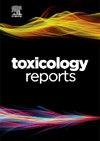LC-Q-Orbitrap液相色谱法测定香肠肠衣和小龙虾中硝基呋喃代谢物:方法建立与验证
Q1 Environmental Science
引用次数: 0
摘要
本研究建立并验证了测定香肠肠衣和小龙虾基质中4种硝基呋喃代谢物的分析方法。该方法采用液相色谱-四极-轨道rap高分辨率质谱法(LC-Q-Orbitrap HRMS)对这些代谢物进行分析。根据欧盟委员会实施法规(CIR) EU 2021/808,使用0.25至0.75 μg/kg的三个浓度水平对所开发的方法进行验证。加样回收率为77 % ~ 109 %,重复性和再现性均低于15 %。校准曲线线性良好,相关系数(R)大于0.9978。检出限为0.0218 ~ 0.0596 μg/kg,定量限为0.0719 ~ 0.1966 μg/kg。决策限(CCα)和检测能力(CCβ)值分别为0.30 ~ 0.39 μg/kg和0.29 ~ 0.35 μg/kg。在埃及当地市场收集的30个小龙虾样本中,16.66 %含有NF代谢物残留,而香肠肠衣则没有NF代谢物残留。通过成功参与两轮能力测试(PT),进一步证明了该方法的可靠性。本文章由计算机程序翻译,如有差异,请以英文原文为准。
Determination of nitrofuran metabolites in sausage casings and crawfish using LC-Q-Orbitrap HRMS: Method development and validation
This study developed and validated an analytical method for determining four nitrofuran (NF) metabolites in sausage casings and crawfish matrices. The method utilizes liquid chromatography coupled with quadrupole-Orbitrap high-resolution mass spectrometry (LC-Q-Orbitrap HRMS) to analyze these metabolites. The validation of the developed method was carried out in accordance with the Commission Implementing Regulation (CIR) EU 2021/808, using three concentration levels ranging from 0.25 to 0.75 μg/kg. The recoveries ranged from 77 % to 109 %, while both repeatability and reproducibility remained consistently below 15 %. The calibration curves exhibited good linearity, with correlation coefficients (R) exceeding 0.9978. The limits of detection (LOD) ranged from 0.0218 to 0.0596 μg/kg, while the limits of quantification (LOQ) ranged from 0.0719 to 0.1966 μg/kg. The decision limit (CCα) and detection capability (CCβ) values ranged from 0.30 to 0.39 μg/kg and 0.29–0.35 μg/kg, respectively. Out of 30 crawfish samples collected from local markets in Egypt, 16.66 % contained NF metabolites residues, whereas sausage casings showed no NF metabolite residues. The reliability of the method was further demonstrated through successful participation in two proficiency testing (PT) rounds.
求助全文
通过发布文献求助,成功后即可免费获取论文全文。
去求助
来源期刊

Toxicology Reports
Environmental Science-Health, Toxicology and Mutagenesis
CiteScore
7.60
自引率
0.00%
发文量
228
审稿时长
11 weeks
 求助内容:
求助内容: 应助结果提醒方式:
应助结果提醒方式:


